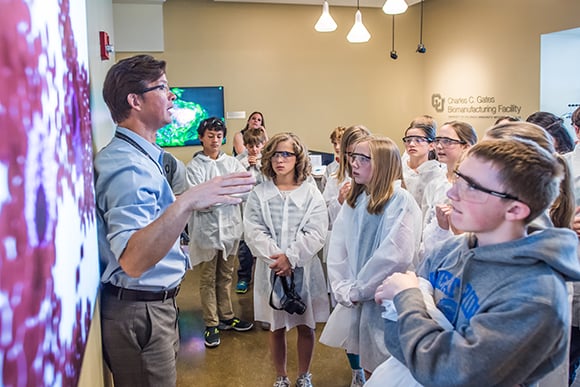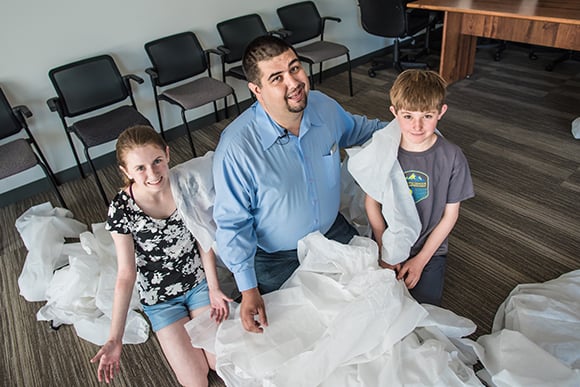The future of medicine is happening at the Gates Biomanufacturing Facility (GBF), and engineers are already working to hand it down to the next generation. The GBF hosted 30 seventh and eighth graders from Bell Middle School (BMS) to introduce them to drug treatments and cellular therapies produced through research in regenerative medicine and stem cell biology.
 Patrick Gaines addresses a group of seventh and eighth graders from Bell Middle School.
Patrick Gaines addresses a group of seventh and eighth graders from Bell Middle School.
A field trip to a cutting-edge facility that translates the discoveries of clinical and commercial investigators into clinical-grade products might sound a bit advanced for middle school students. However, Patrick Gaines, executive director of the Gates Center for Regenerative Medicine, knew they would be able to understand the basic concepts and could use the trip to potentially inspire careers in science.
“By seventh and eighth grade kids have been exposed to the basics of biology,” Gaines said. “They’ve learned what a cell is and the function in a living organism. Middle school students are a terrific group to bring in since they understand the principles. This is our chance to show them a glimpse into the future.”
The trip they chose
The trip, which was arranged by BMS STEM science teachers Shanna Atzmiller and Nicole King, built on curriculum students had completed on cellular function and structure.
“Our STEM programs are career based, so we are scheduling career exploration field trips so students can apply the skills and knowledge they have gained in class,” Atzmiller said. “All of the students here chose this trip specifically because they were very interested in cells and stem cell research.”
Seventh grader Connor Logan jumped at the opportunity to tour the facility. He is so interested in the implications of cell research that the GBF even won out over other field trip options, which included the zoo and a nuclear reactor.
“I thought it was fascinating to see the lab,” Logan said. “It’s the type of thing you see in the newspaper or in videos, but I never thought I’d actually be looking at one in person.”
Even before leaving the lab, Logan was already coming up with ideas on how stem cell research could be taken further, including applying the technology to plants to synthesize chloroplasts that photosynthesize all day and start cellular respiration at night—thus potentially creating an everlasting lifeform.
 Gabe Orosco's knowledge was put to the test by students like Grace Searls and Connor Logan.
Gabe Orosco's knowledge was put to the test by students like Grace Searls and Connor Logan.
Eighth grader Grace Searls chose to visit the GBF because she has witnessed several family members with genetic conditions. She was particularly curious what the limitations are of cell therapy and how far it will advance in the future.
“I enjoy research science, and I hope cell therapy is one of the ways we could help fix some of the diseases in my family,” Searls said.
Touring the future
The tour included a preliminary discussion about the facility led by Lead Engineer and Director of Quality Assurance Gabe Orosco. Orosco discussed the work being done at the GBF and rapid growth of the field. He also emphasized how the students were already preparing for potential careers as researchers and scientists.
“Science isn’t just about the facts, it’s about the people who do it,” Orosco said. “Your ability to solve problems, ask questions, collaborate with your classmates and imagine new ideas is prepping you for actual scientific knowledge and for being able to do what I do.”
The tour included clean rooms, a “miniature hospital,” and development facilities and equipment such as microbial cell fermenters. Along the way Orosco and Gaines took questions about the current uses of stem cells and discussed the implications of their growing prominence in medicine.
“Manipulating adult stem cells and returning them to their embryonic-like state is a great power,” said Gaines. “It is important that these kids understand the potential uses and leave with a broad imagination about the kind of problems they can solve one day.”




